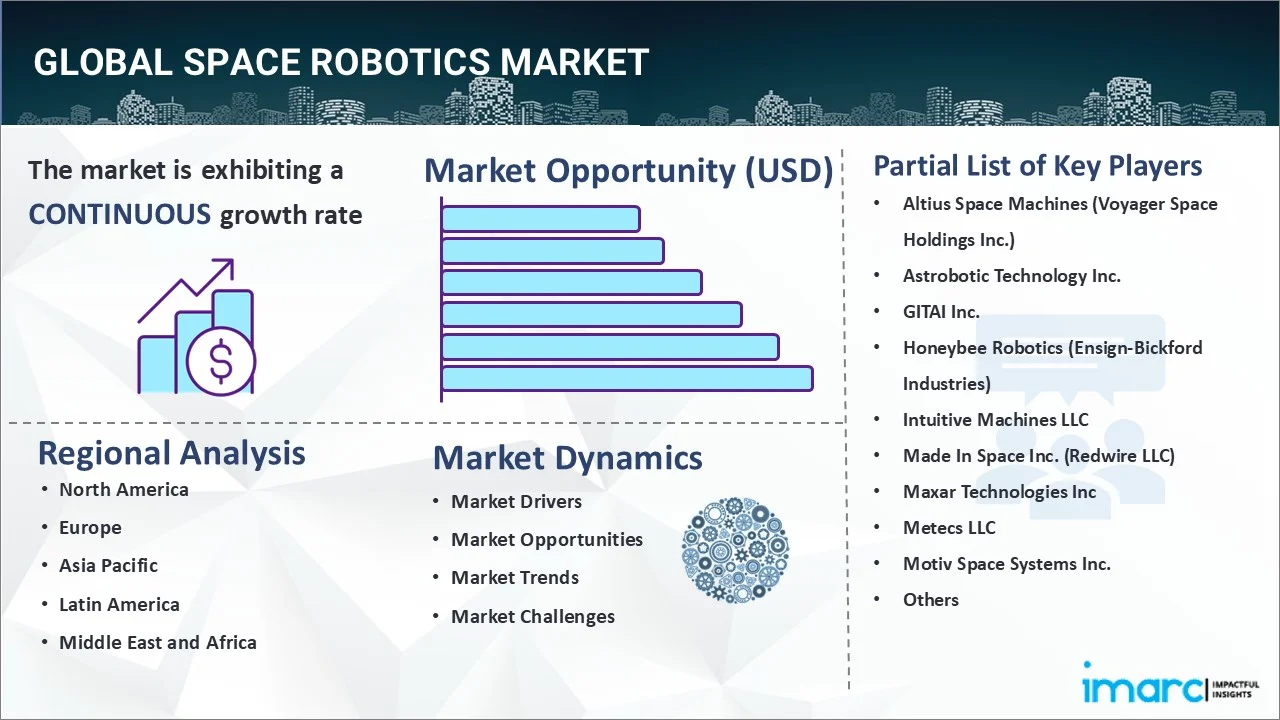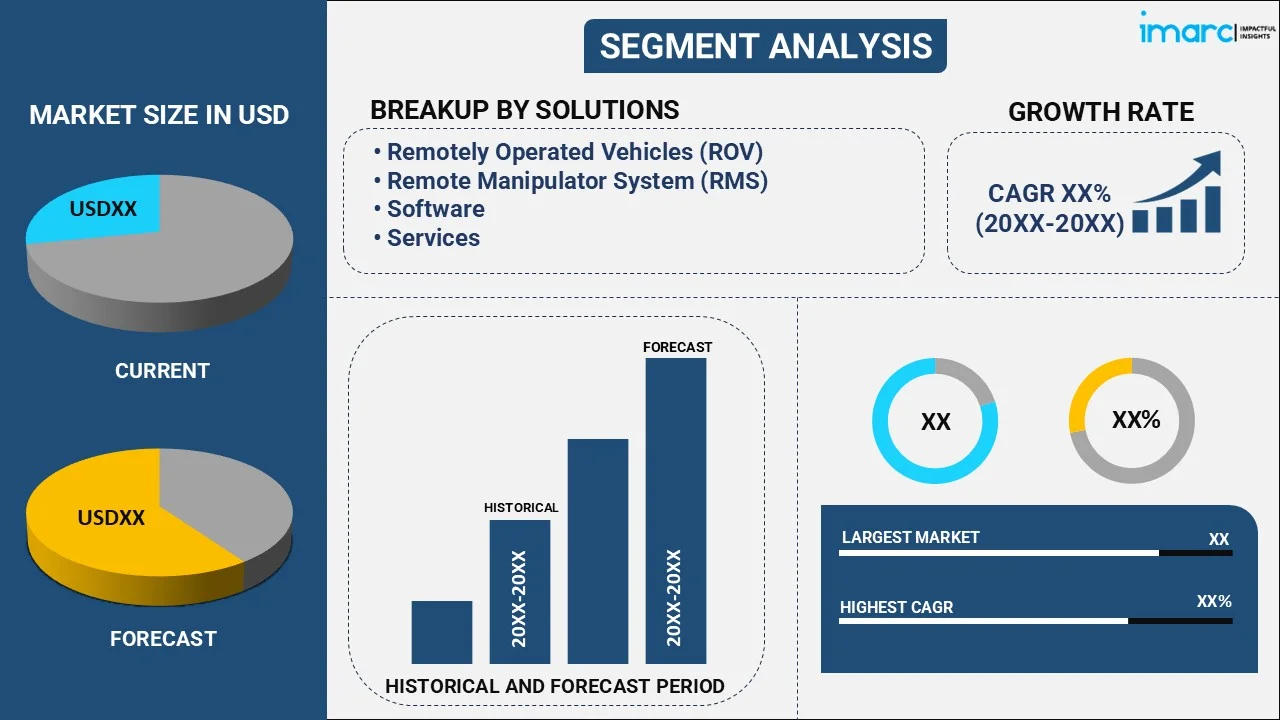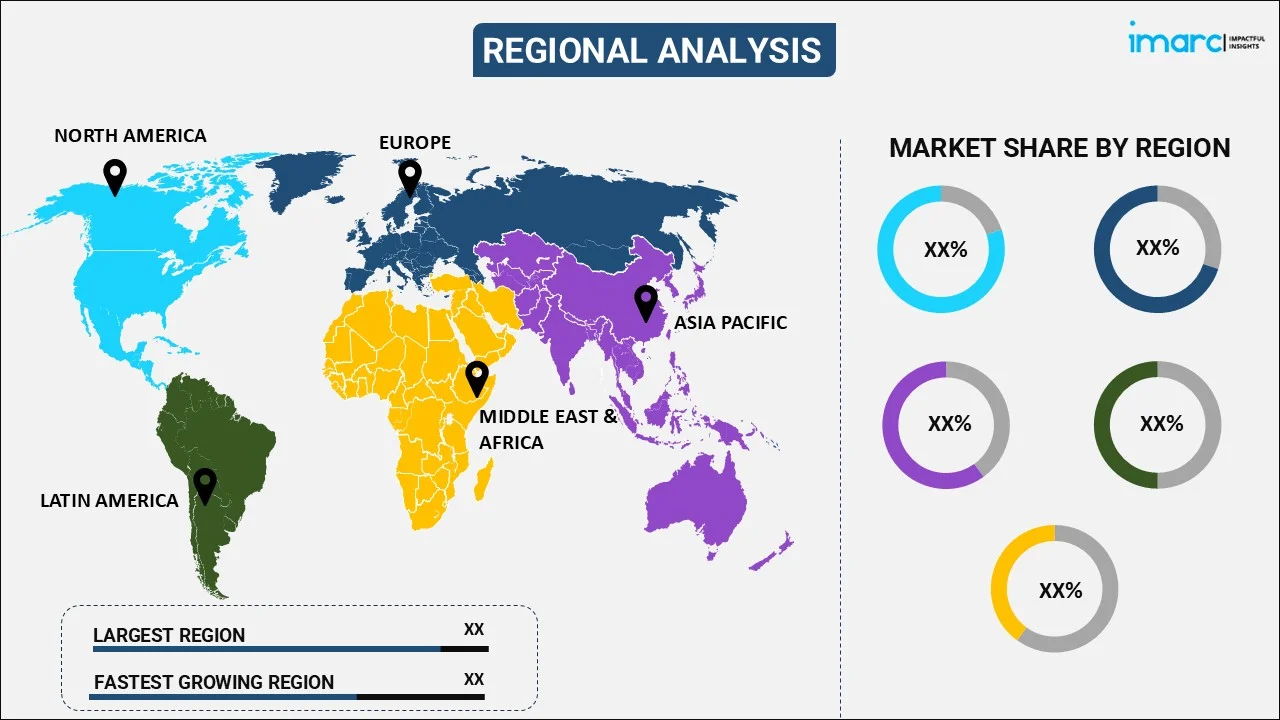
Space Robotics Market Report by Solution (Remotely Operated Vehicles (ROV), Remote Manipulator System (RMS), Software, Services), Application (Deep Space, Near Space, Ground), End Use (Commercial, Government), and Region 2025-2033
Market Overview 2025-2033:
The global space robotics market size reached USD 5.1 Billion in 2024. Looking forward, IMARC Group expects the market to reach USD 10.4 Billion by 2033, exhibiting a growth rate (CAGR) of 7.4% during 2025-2033.
|
Report Attribute
|
Key Statistics
|
|---|---|
|
Base Year
|
2024 |
|
Forecast Years
|
2025-2033
|
|
Historical Years
|
2019-2024
|
| Market Size in 2024 | USD 5.1 Billion |
| Market Forecast in 2033 | USD 10.4 Billion |
| Market Growth Rate (2025-2033) | 7.4% |
Space robotics refers to a field of science and engineering that assists in space missions and exploration activities. It is used in assembling, maintenance, satellite services and meeting requirements in extremely hostile environments of space. It utilizes space robots for minimizing costs, accelerating schedules, improving overall performance and incurring minimal risks. These robots extend the human ability to operate in space by providing greater handling capabilities to astronauts. As a result, space robotics finds extensive application in autonomously operating on a new planetary surface.

Space Robotics Market Trends:
A significant need for efficient repair, servicing and maintenance of geostationary satellites represents one of the key factors catalyzing the demand for space robots across the globe. Apart from this, various technological advancements, in confluence with the increasing utilization of autonomous systems in space and the growing number of space programs, are also contributing to the market growth. For instance, the European Commission funded PERASPERA and SpacePlan 2020, which is coordinated by the European Space Agency (ESA) for planning technology roadmaps in space robotics. Project PERASPERA aims to develop an integrated plan for space robotics technology during 2023-2024. Furthermore, emerging technologies, such as deep learning (DL) and artificial intelligence (AI), are extensively being used in the robotics industry, which, in turn, is fueling the market growth. Moreover, the key players are introducing AI-based robots that enhance mobility in space and provide greater exploration benefits. These robots can also perform highly complex tasks for a longer duration and can operate with minimum human aid.
Key Market Segmentation:
IMARC Group provides an analysis of the key trends in each segment of the global space robotics market report, along with forecasts at the global, regional and country levels from 2025-2033. Our report has categorized the market based on solution, application and end use.
Breakup by Solution:

- Remotely Operated Vehicles (ROV)
- Rovers/Spacecraft Landers
- Space Probes
- Others
- Remote Manipulator System (RMS)
- Robotic Arms/Manipulator Systems
- Gripping and Docking Systems
- Others
- Software
- Services
Breakup by Application:
- Deep Space
- Space Transportation
- Space Exploration
- Others
- Near Space
- Space Transportation
- Space Exploration
- In-Space Maintenance
- Others
- Ground
Breakup by End Use:
- Commercial
- Government
Breakup by Region:

- North America
- United States
- Canada
- Asia-Pacific
- China
- Japan
- India
- South Korea
- Australia
- Indonesia
- Others
- Europe
- Germany
- France
- United Kingdom
- Italy
- Spain
- Russia
- Others
- Latin America
- Brazil
- Mexico
- Others
- Middle East and Africa
Competitive Landscape:
The competitive landscape of the industry has also been examined along with the profiles of the key players being Altius Space Machines (Voyager Space Holdings Inc.), Astrobotic Technology Inc., GITAI Inc., Honeybee Robotics (Ensign-Bickford Industries), Intuitive Machines LLC, Made In Space Inc. (Redwire LLC), Maxar Technologies Inc, Metecs LLC, Motiv Space Systems Inc., Northrop Grumman Corporation, Oceaneering International Inc. and Olis Robotics.
Report Coverage:
| Report Features | Details |
|---|---|
| Base Year of the Analysis | 2024 |
| Historical Period | 2019-2024 |
| Forecast Period | 2025-2033 |
| Units | Billion USD |
| Segment Coverage | Solution, Application, End Use, Region |
| Region Covered | Asia Pacific, Europe, North America, Latin America, Middle East and Africa |
| Countries Covered | United States, Canada, Germany, France, United Kingdom, Italy, Spain, Russia, China, Japan, India, South Korea, Australia, Indonesia, Brazil, Mexico |
| Companies Covered | Altius Space Machines (Voyager Space Holdings Inc.), Astrobotic Technology Inc., GITAI Inc., Honeybee Robotics (Ensign-Bickford Industries), Intuitive Machines LLC, Made In Space Inc. (Redwire LLC), Maxar Technologies Inc, Metecs LLC, Motiv Space Systems Inc., Northrop Grumman Corporation, Oceaneering International Inc. and Olis Robotics |
| Customization Scope | 10% Free Customization |
| Post-Sale Analyst Support | 10-12 Weeks |
| Delivery Format | PDF and Excel through Email (We can also provide the editable version of the report in PPT/Word format on special request) |
Key Questions Answered in This Report
We expect the global space robotics market to exhibit a CAGR of 7.4% during 2025-2033.
The escalating need for efficient servicing, repair, and maintenance of geostationary satellites, along with the advent of AI-based robots that enhance mobility in space with greater exploration benefits, is primarily driving the global space robotics market.
The sudden outbreak of the COVID-19 pandemic had led to the implementation of stringent lockdown regulations across several nations resulting in the temporary halt in numerous space missions and exploration activities, thereby negatively impacting the global space robotics market.
Based on the solution, the global space robotics market can be categorized into Remotely Operated Vehicles (ROV), Remote Manipulator System (RMS), software, and services. Currently, services account for the majority of the global market share.
Based on the application, the global space robotics market has been segregated into deep space, near space, and ground. Among these, near space currently holds the largest market share.
Based on the end use, the global space robotics market can be bifurcated into commercial and government. Currently, the government sector exhibits a clear dominance in the market.
On a regional level, the market has been classified into North America, Asia Pacific, Europe, Latin America, and Middle East and Africa, where North America currently dominates the global market.
Some of the major players in the global space robotics market include Altius Space Machines (Voyager Space Holdings Inc.), Astrobotic Technology Inc., GITAI Inc., Honeybee Robotics (Ensign-Bickford Industries), Intuitive Machines LLC, Made In Space Inc. (Redwire LLC), Maxar Technologies Inc, Metecs LLC, Motiv Space Systems Inc., Northrop Grumman Corporation, Oceaneering International Inc., and Olis Robotics.
Need more help?
- Speak to our experienced analysts for insights on the current market scenarios.
- Include additional segments and countries to customize the report as per your requirement.
- Gain an unparalleled competitive advantage in your domain by understanding how to utilize the report and positively impacting your operations and revenue.
- For further assistance, please connect with our analysts.
 Request Customization
Request Customization
 Speak to an Analyst
Speak to an Analyst
 Request Brochure
Request Brochure
 Inquire Before Buying
Inquire Before Buying




.webp)




.webp)












